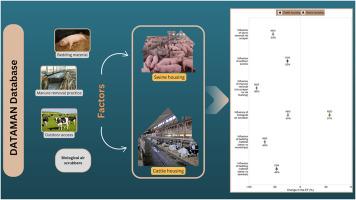Mitigation of greenhouse gas and ammonia emissions due to livestock housing management practices: Analysis of the DATAMAN database
IF 5.3
1区 农林科学
Q1 AGRICULTURAL ENGINEERING
引用次数: 0
Abstract
This study analysed management effects on methane (CH4), nitrous oxide (N2O) and ammonia (NH3) emissions from pig and cattle houses, using the global DATAMAN-Housing database. Emission factor (EF) data was grouped by animal sub-category and manure type, and single-variable linear models of EF with housing practice variables (e.g. air scrubber, bedding material, with identified control values) were developed. These variables were examined for statistically significant effects on mean EFs. In closed growing pig housing systems, replacing straw with sawdust-based bedding reduced (p = 0.012) the mean EFCH4 by 46 %. In deep pit growing pig houses, installing biological air scrubbers at the air outlet decreased the mean EFNH3 (p = 0.031) by 24 %. Limited N2O data showed an increased EFN2O by 57 % (p < 0.0001), but careful interpretation is required due to the low number of observations. Frequent slurry removal from the pit below slatted floors using a scraper lowered (p = 0.011) the mean EFNH3 by 53 %. In cubicle and loose cattle houses the mean EFNH3 decreased when using woodchips instead of straw bedding and when changing from manure removal via scraper to flushing. The latter effects need cautious interpretation due to small sample sizes and differences in potential NH3 emission driving factors. While these findings are promising, many practices had limited observations. Further studies are required to better quantify these practices’ mitigation potential for pig and cattle houses, ensuring co-benefits and trade-offs for all gases are captured, with data collated in the DATAMAN database for improved quantification.

减少牲畜舍管理做法造成的温室气体和氨排放:对DATAMAN数据库的分析
本研究利用全球DATAMAN-Housing数据库分析了管理对猪舍和牛舍甲烷(CH4)、氧化亚氮(N2O)和氨(NH3)排放的影响。排放因子(EF)数据按动物亚类和粪便类型分组,并建立了带有住房实践变量(如空气洗涤器、垫层材料)的单变量线性模型,并确定了控制值。对这些变量进行检验,看是否对平均EFs有统计学上的显著影响。在封闭式猪舍系统中,用木屑为基础的垫层代替稻草可使EFCH4平均降低46% (p = 0.012)。在深坑生长猪舍中,在出风口安装生物空气洗涤器可使EFNH3平均降低24% (p = 0.031)。有限的N2O数据显示,EFN2O增加了57% (p <;0.0001),但由于观测数量少,需要仔细解释。使用刮刀从板条地板下方的坑中频繁清除浆液,使平均EFNH3降低了53% (p = 0.011)。在小隔间和松散的牛舍中,当使用木片代替稻草垫层,以及从通过刮刀清除粪便改为通过冲洗时,平均EFNH3下降。由于样本量小,且潜在NH3排放驱动因子存在差异,后一种效应需要谨慎解释。虽然这些发现很有希望,但许多实践的观察结果有限。需要进一步的研究来更好地量化这些做法对猪舍和牛舍的减排潜力,确保捕获所有气体的共同效益和权衡,并将数据整理在DATAMAN数据库中,以改进量化。
本文章由计算机程序翻译,如有差异,请以英文原文为准。
求助全文
约1分钟内获得全文
求助全文
来源期刊

Biosystems Engineering
农林科学-农业工程
CiteScore
10.60
自引率
7.80%
发文量
239
审稿时长
53 days
期刊介绍:
Biosystems Engineering publishes research in engineering and the physical sciences that represent advances in understanding or modelling of the performance of biological systems for sustainable developments in land use and the environment, agriculture and amenity, bioproduction processes and the food chain. The subject matter of the journal reflects the wide range and interdisciplinary nature of research in engineering for biological systems.
 求助内容:
求助内容: 应助结果提醒方式:
应助结果提醒方式:


